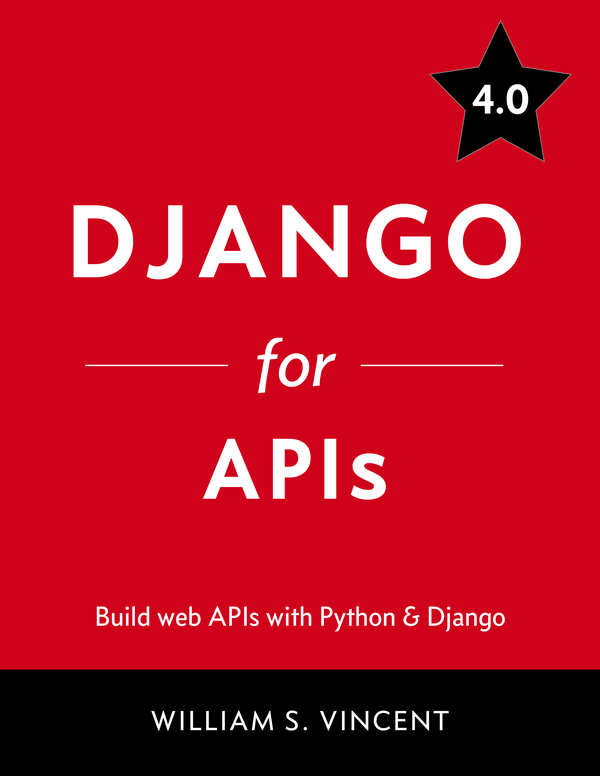Download Django for APIs 4.0: Build Web APIs with Python and Django PDF Free - Full Version
Download Django for APIs 4.0: Build Web APIs with Python and Django by William S. Vincent in PDF format completely FREE. No registration required, no payment needed. Get instant access to this valuable resource on PDFdrive.to!
About Django for APIs 4.0: Build Web APIs with Python and Django
<p>Learn how to build web APIs with Python and Django.</p><p>Take a modern API-first approach to creating 3 different Django back-ends: a Library API, Todo API, and a Blog API with user authentication, permissions, proper documentation, and more. You'll even learn how to connect them to a React front-end for a truly full-stack web application.</p><p>What’s New for 4.0</p><p>*Django 4.0 and Django REST Framework 3.13 throughout.</p><p>*Updated to Python 3.10.</p><p>*Added full chapter on proper set up with Python, Django, Black, Git, and more.</p><p>*Switched to Pip from Pipenv, which is a major change but feels warranted given Pipenv has slowed in development and Pip is the default for many people. I don’t get into fancier configuration options because “it all depends” once you do and using Pip is fine for a single developer starting out.</p><p>*Windows-first support. I bought a Microsoft Surface laptop and have been dutifully using it several days a week. I still greatly prefer macOS but most of the world uses Windows so I have run through all the code and updated the text to ensure Windows works well.</p><p>*Updated all the third-party packages to the latest versions, which means django-cors-headers, django-rest-auth, django-allauth, gunicorn, psycopg, whitenoise, and environs.</p><p>*Added environment variables for proper security and deployment</p><p>*Much more material on testing both Django and Django REST Framework in all projects</p><p>*Deployment configured in depth for all 3 projects built in the book</p><p>*Fixed a previous bug in Chapter 7 around permissions so it is properly locked down now. Also covers custom permissions in far more depth.</p><p>*Switched the default project name from config to django_project to avoid any confusion among readers.</p><p>*Switched to drf-spectacular for documentation in align with recent Django REST Framework trends</p><p>*Switch from pip install to python -m pip install because Adam Johnson said to.</p><p>*All new screenshots since Chrome updates even more often than Django.</p><p>*Switch to main from master for Git branch.<br></p>
Detailed Information
| Author: | William S. Vincent |
|---|---|
| Publication Year: | 2022 |
| Language: | other |
| File Size: | 4.7201 |
| Format: | |
| Price: | FREE |
Safe & Secure Download - No registration required
Why Choose PDFdrive for Your Free Django for APIs 4.0: Build Web APIs with Python and Django Download?
- 100% Free: No hidden fees or subscriptions required for one book every day.
- No Registration: Immediate access is available without creating accounts for one book every day.
- Safe and Secure: Clean downloads without malware or viruses
- Multiple Formats: PDF, MOBI, Mpub,... optimized for all devices
- Educational Resource: Supporting knowledge sharing and learning
Frequently Asked Questions
Is it really free to download Django for APIs 4.0: Build Web APIs with Python and Django PDF?
Yes, on https://PDFdrive.to you can download Django for APIs 4.0: Build Web APIs with Python and Django by William S. Vincent completely free. We don't require any payment, subscription, or registration to access this PDF file. For 3 books every day.
How can I read Django for APIs 4.0: Build Web APIs with Python and Django on my mobile device?
After downloading Django for APIs 4.0: Build Web APIs with Python and Django PDF, you can open it with any PDF reader app on your phone or tablet. We recommend using Adobe Acrobat Reader, Apple Books, or Google Play Books for the best reading experience.
Is this the full version of Django for APIs 4.0: Build Web APIs with Python and Django?
Yes, this is the complete PDF version of Django for APIs 4.0: Build Web APIs with Python and Django by William S. Vincent. You will be able to read the entire content as in the printed version without missing any pages.
Is it legal to download Django for APIs 4.0: Build Web APIs with Python and Django PDF for free?
https://PDFdrive.to provides links to free educational resources available online. We do not store any files on our servers. Please be aware of copyright laws in your country before downloading.
The materials shared are intended for research, educational, and personal use in accordance with fair use principles.

